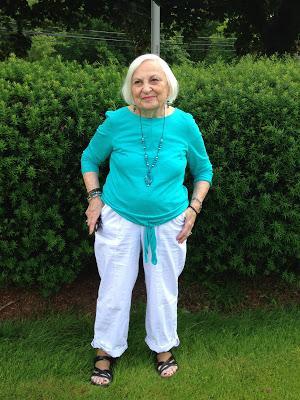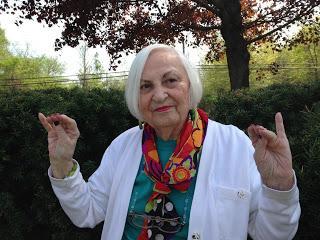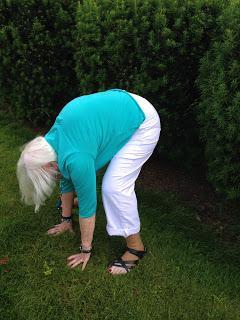 The Fourth Age, according to Stephen F. Barnes, Ph.D. of San Diego State University’s Interwork Institute, is a relatively new term coined to reflect the extension of life over the past few decades and generally refers to individuals age 80 and above. Norma Bursack, age 88, is a Fourth Age Yogi.
The Fourth Age, according to Stephen F. Barnes, Ph.D. of San Diego State University’s Interwork Institute, is a relatively new term coined to reflect the extension of life over the past few decades and generally refers to individuals age 80 and above. Norma Bursack, age 88, is a Fourth Age Yogi.There are three descriptive principles that relate to the Forth Age and Norma’s experience is an excellent illustration of all three. Her experience can serve as a guiding light for those of us who have yet to travel that stage of life.
Principle One: Biological and functional decline becomes more apparent, although research points out important individual differences in both the timing and pattern of decline.
Norma uses the yoga tool of svadhyaya (self-awareness—see LINK) along with a well-developed sense of humor to deal with this principle. She is a two-time cancer survivor (colon cancer in 1994 and cervical cancer at age 85). It was self-awareness of something “not right” that sent her first to one doctor and then to another when the first doctor’s diagnosis didn’t fit what she felt and knew to be true about her body (anamayakosha). Now self-awareness helps her adjust her lifestyle practices post surgery. Since her bout with colon cancer, she has a long list of foods that her digestive system does not tolerate, and she finds it easier to eat five small meals or snacks a day. In addition, she wears a hearing aid and often needs compression socks for swollen ankles due to water retention. However, the socks are worn with the toes cut out to show off her pedicure.
Another yoga tool that is helpful with this principle is santosha. Santosha is defined as contentment (see LINK). When we practice santosha we learn to accept ourselves as we are. This is especially important to practice as our bodies change with age. Norma’s practice of santosha is clear in the following poem that popped into her head at 3:00 a.m. one morning at age 80.
What Do You Expect, I’m 80
By Norma J. Bursack
I once had a waist and perky boobs
And hips that didn’t resemble tubes
A neck that turned painlessly left or right
To allow for safe oncoming traffic sight
Everything seems to be headed south
Wonder what became of my mouth
I’m a couple of inches closer to the ground
But grateful and happy to still be around
Principle Two: The need arises for social and cultural support in order maintain high levels of functioning.
Norma currently lives in a supportive, independent living community for older adults. The recreation department addresses the need for social and cultural support by planning a wide variety of activities to foster social interaction and community building. These activities include exercise classes, yoga classes, arts and cultural activities and field trips, all focused on encouraging the all-important positive mental attitude toward the aging process.
“Scientists are discovering something very peculiar about aging: How we feel about getting old matters. A lot. In test after test, researchers are finding that if we think about getting older in terms of decline or disability, our health likely will suffer. If, on the other hand, we see aging in terms of opportunity and growth, our bodies respond in kind.” —Anne Tergesen from “To Age Well, Change How You Feel About Aging.”LINK?
One yoga tool that Norma has learned in her yoga class is Hansi mudra, gesture of the Inner Smile. It can be helpful in developing and sustaining a positive attitude. The word ‘Hansi” refers to smiling and laughter and is thought to direct the breath into the upper chest, neck and head, cultivating an experience of joy, lightness and the unfolding of positive qualities. Norma regularly practices this.
 Instructions:
Instructions:- In your favorite seated position, with both hands, curl your index, middle, and ring fingers in so the tips of the fingers touch the tips of the thumbs.
- Extend your little fingers straight out.
- Rest the backs of your hands on the thighs or knees, or hold your hands by the sides of the body with the little fingers pointing upward (this option works well if you choose to do the mudra in a standing position).
- Relax your shoulders back and down, and maintain your spine in its natural curves.
- Hold for 5 to 10 breaths, or as long as you’re comfortable.
Norma’s relationship to the third principle of the Forth Age demonstrates that it’s never too late to begin a yoga practice. Some years ago, yoga was offered to residents of her community but she didn’t pursue it because it conflicted with her water aerobics class. That changed about two years ago, and she now attends yoga classes twice a week. She says she committed to attending the yoga classes after the first one:
“Classes are like a relief or escape from everyday worries. Eyes closed, soft music and pleasant vocal instructions are most welcome and soothing. I feel my benefits from yoga fall into a spiritual category. It’s hard to explain the feeling. I somehow relate it to the release of an anchor freeing a vessel to be seaborne.”
That last line, “I somehow relate it to the release of an anchor freeing a vessel to be seaborne” is an insightful metaphor, and it would not be surprising to see it pop up in one of her new poems!
She finds the yoga stretches rewarding and says, "I feel I can credit yoga classes to my new-found ability to easily bend down and touch the floor."
 In addition to her twice-weekly yoga classes, Norma is creative and engaged with life, her family, and her community. She concentrates on keeping her mind active and her attitude positive. She writes poetry, stories, and plays. Her apartment is filled with books, family photos, and binders of her writing. Her attitude is also apparent in how she dresses and carries herself. Her hair, clothes, and jewelry all give the impression of someone who practices self-care and expresses herself in ways to positively influence her aging process. She is a shining example of an active Forth Age Yogi.
In addition to her twice-weekly yoga classes, Norma is creative and engaged with life, her family, and her community. She concentrates on keeping her mind active and her attitude positive. She writes poetry, stories, and plays. Her apartment is filled with books, family photos, and binders of her writing. Her attitude is also apparent in how she dresses and carries herself. Her hair, clothes, and jewelry all give the impression of someone who practices self-care and expresses herself in ways to positively influence her aging process. She is a shining example of an active Forth Age Yogi.Subscribe to Yoga for Healthy Aging by Email ° Follow Yoga for Healthy Aging on Facebook ° Join this site with Google Friend Connect

